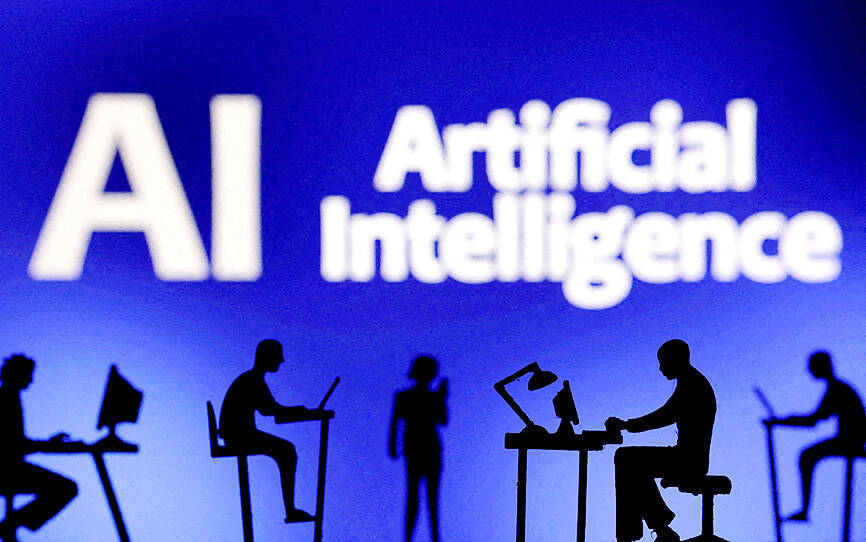Over the next two weeks, the quarterly results of tech giants would offer a glimpse of the bankability of artificial intelligence (AI) and whether the major investments AI requires are sustainable for the long haul.
Analysts at Wedbush Securities Inc, one of Wall Street’s biggest believers in AI’s potential, expect “growth and earnings to accelerate with the AI revolution and the wave of transformation” it is causing.
The market generally agrees with this rosy AI narrative. Analysts forecast double-digit growth for heavyweights Microsoft Corp and Google, in contrast to Apple Inc, a latecomer to the AI party, with only 3 percent growth expected.

Photo: Reuters
The iPhone maker, which releases its results on Thursday next week, unveiled its new Apple Intelligence system only last month and plans to roll it out gradually over the next months, and only on the latest models.
CFRA Research analyst Angelo Zino said Apple’s upcoming earnings would show improvement in China sales, a black spot since last year.
“Apple’s forecasts for the current quarter will be important” in assessing the company’s momentum, he added.
Zino said he was a little bit more concerned about Meta Platforms Inc, which raised its investment projections in April last year as it devoted a few billion dollars more on the chips, servers and data centers needed to develop generative AI.
CFRA expects Meta’s growth to decelerate through the end of the year. Combined with the expected increase in spending on AI, that should put earnings under pressure.
As for the earnings of cloud giants Microsoft (which is to release its results on Tuesday next week) and Amazon (which is to release its results on Thursday next week), “we expect them to continue to report very good results, in line with or better than market expectations,” Zino said.
Microsoft is among the best positioned to monetize generative AI, having moved the fastest to implement it across all its products, and pouring US$13 billion into OpenAI, the start-up stalwart behind ChatGPT.
Winning the big bet on AI is “crucial” for the group, Emarketer analyst Jeremy Goldman said, “but the market is willing to give them a level of patience.”
The AI frenzy has helped Microsoft’s cloud computing business grow in the double digits, something that analysts said could be hard to sustain.
“This type of growth cannot hold forever, but the synergies between cloud and AI make it more likely that Microsoft holds onto reliable cloud growth for some time to come,” Goldman said.
As for Amazon.com Inc, “investors will want to see that the reacceleration of growth over the first quarter wasn’t a one-off” at Amazon Web Services (AWS), the company’s world-leading cloud business, Hargreaves Lansdown PLC analyst Matt Britzman said.
Since AWS leads “in everything data-related, it should be well placed to capture a huge chunk of the demand coming from the AI wave,” Britzman said.
The picture “might be a little less clear” for Google parent Alphabet Inc, which would be the first to publish results on Tuesday, “because of their search business” online, Zino said.
“Skepticism around AI Overviews,” introduced by Google in mid-May, “is certainly justified,” Emarketer analyst Evelyn Mitchell-Wolf said.
This new feature, which offers a written text at the top of results in a Google search, ahead of the traditional links to sites, got off to a rocky start.
Internet users were quick to report strange, or potentially dangerous, answers proposed by the feature that had been touted by Google executives as the future direction of search.
Data compiled by BrightEdge and relayed by Search Engine Land showed that the number of searches presenting a result generated by AI Overviews has plummeted in recent weeks as Google shies away from the feature.
Still, many are concerned about the evolution of advertising across the Internet if Google pushes on with the Overviews model, which reduces the necessity of clicking on links. Content creators, primarily the media, fear a collapse in revenues.
“As long as Google maintains its status as the default search engine across most smartphones and major browsers, it will continue to be the top destination for search, and the top destination for search ad spending,” Mitchell-Wolf said.

UNCERTAINTY: Innolux activated a stringent supply chain management mechanism, as it did during the COVID-19 pandemic, to ensure optimal inventory levels for customers Flat-panel display makers AUO Corp (友達) and Innolux Corp (群創) yesterday said that about 12 to 20 percent of their display business is at risk of potential US tariffs and that they would relocate production or shipment destinations to mitigate the levies’ effects. US tariffs would have a direct impact of US$200 million on AUO’s revenue, company chairman Paul Peng (彭雙浪) told reporters on the sidelines of the Touch Taiwan trade show in Taipei yesterday. That would make up about 12 percent of the company’s overall revenue. To cope with the tariff uncertainty, AUO plans to allocate its production to manufacturing facilities in

Taiwan will prioritize the development of silicon photonics by taking advantage of its strength in the semiconductor industry to build another shield to protect the local economy, National Development Council (NDC) Minister Paul Liu (劉鏡清) said yesterday. Speaking at a meeting of the legislature’s Economics Committee, Liu said Taiwan already has the artificial intelligence (AI) industry as a shield, after the semiconductor industry, to safeguard the country, and is looking at new unique fields to build more economic shields. While Taiwan will further strengthen its existing shields, over the longer term, the country is determined to focus on such potential segments as

TAKING STOCK: A Taiwanese cookware firm in Vietnam urged customers to assess inventory or place orders early so shipments can reach the US while tariffs are paused Taiwanese businesses in Vietnam are exploring alternatives after the White House imposed a 46 percent import duty on Vietnamese goods, following US President Donald Trump’s announcement of “reciprocal” tariffs on the US’ trading partners. Lo Shih-liang (羅世良), chairman of Brico Industry Co (裕茂工業), a Taiwanese company that manufactures cast iron cookware and stove components in Vietnam, said that more than 40 percent of his business was tied to the US market, describing the constant US policy shifts as an emotional roller coaster. “I work during the day and stay up all night watching the news. I’ve been following US news until 3am

COLLABORATION: Given Taiwan’s key position in global supply chains, the US firm is discussing strategies with local partners and clients to deal with global uncertainties Advanced Micro Devices Inc (AMD) yesterday said it is meeting with local ecosystem partners, including Taiwan Semiconductor Manufacturing Co (TSMC, 台積電), to discuss strategies, including long-term manufacturing, to navigate uncertainties such as US tariffs, as Taiwan occupies an important position in global supply chains. AMD chief executive officer Lisa Su (蘇姿丰) told reporters that Taiwan is an important part of the chip designer’s ecosystem and she is discussing with partners and customers in Taiwan to forge strong collaborations on different areas during this critical period. AMD has just become the first artificial-intelligence (AI) server chip customer of TSMC to utilize its advanced